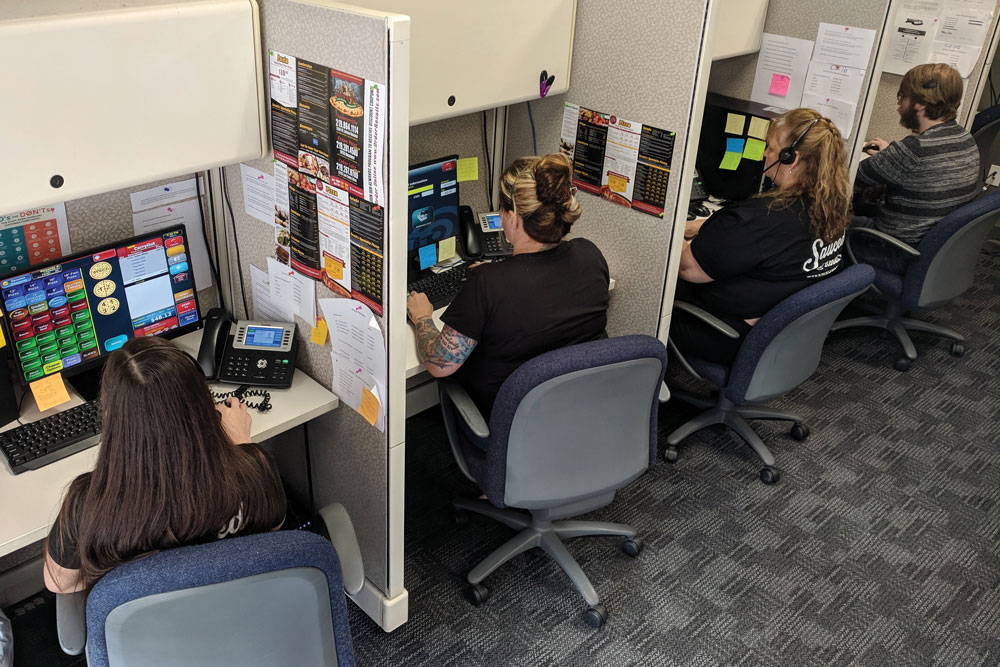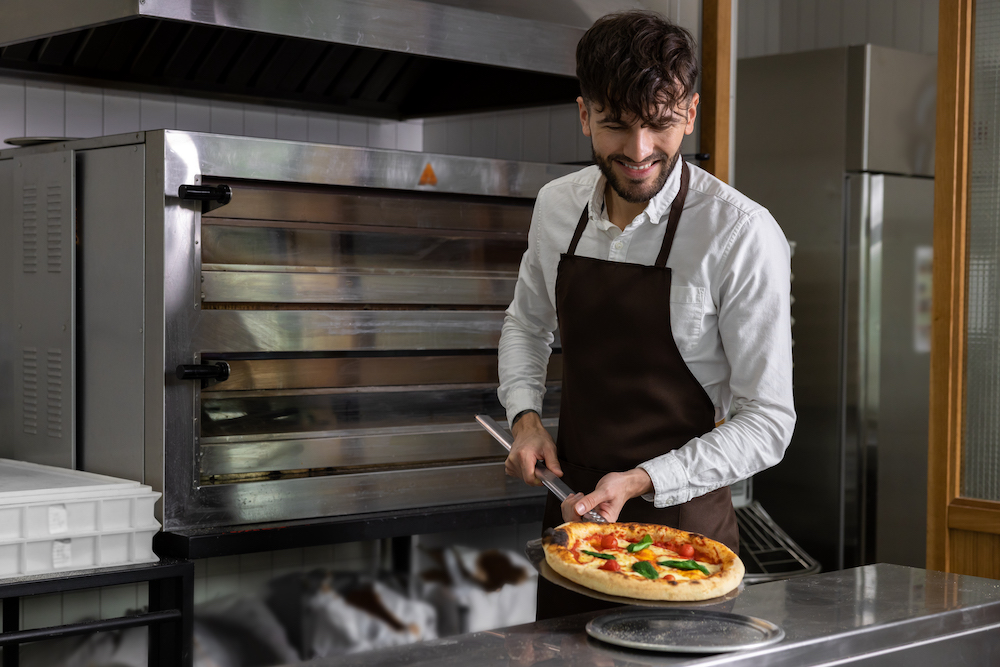There’s one surefire way to lose a call-in pizza order: Put the customer on hold and forget about him. Or leave him on hold for so long that he feels forgotten and hangs up. Either way, that customer will likely take his business somewhere else that day and might never call—or come back to—your store again.
It’s an age-old plight for any pizzeria that accepts orders over the phone. And make no mistake—phone orders are still big business. A 2019 study by SMG, a global customer and employee experience provider, found that nearly one-third of customers order pizza by phone. Not surprisingly, the solution to managing all of those phone orders is at least partially based on technology. Automated phone systems have changed the customer experience in recent years, creating upsell opportunities while keeping callers on the line longer—without ticking them off. But some pizza chains have taken it one step further, adding in-house call centers or outsourcing phone-answering duties to third-party companies.
Call centers were once a privilege reserved for industry giants like Domino’s and Pizza Hut. Not any longer, says Kevin Leidecker, owner of N.Y.P.D. Pizza, with four locations in the Cincinnati area. “The [call-center] technology and software that existed five years ago wasn’t ready for somebody of my size,” says Leidecker, who only recently added his fourth store. “Finally, at this point, technology is a great equalizer, and I can compete with four stores and make it effective, provide a better experience for my customers and make more money.”
“The [call-center] technology and software that existed five years ago wasn’t ready for somebody of my size. Finally, at this point…I can compete with four stores and make it effective, provide a better experience for my customers and make more money.”
— Kevin Leidecker, N.Y.P.D. Pizza
Please Stay On the Line
A Google Consumer Survey in 2019 found customers will wait on hold no longer than two minutes before hanging up. And a study by Voice Response Inc. found that more than one in three customers will never call back if they’re left on hold for too long.
For pizzerias fielding more phone orders than usual while riding out the coronavirus pandemic this spring, every call mattered. But taking each call in a timely manner is always a challenge on a busy day, pandemic or no pandemic. Fortunately, today’s phone systems offer a number of ways to keep customers engaged while they’re waiting, from start-of-call upsell messages that encourage higher ticket averages to apology messages reassuring the customer that their call is important to the pizzeria. Even on-hold music can make a positive difference: An AT&T survey reported that, on average, customers will hang up after 90 seconds, but listening to music made a 30-second wait feel like only 15 seconds.

Employees in a call center have one job: to answer the phones professionally, quickly and efficiently, which can result in increased ticket averages and happier customers.
Adding a set of upsell on-hold messages, played randomly for each caller, can increase your sales by $400 to $500 a month, says John Scully, who spent many years working in the call-center industry before founding Granville, Ohio-based Pizza Cloud, a telephone/internet solutions company that focuses on the pizzeria industry. “Having custom messages really helps,” Scully says. “You can customize messages [to promote] catering, party rooms and specials.…If it takes you one and a half minutes or two minutes to get to the call on a busy Friday evening and they’re not just listening to nonstop ringing, they’re not upset when they get through to you. It helps keep people from hanging up, which gives you an increase in revenue from orders you wouldn’t have received otherwise.”
But, ideally, you don’t want to keep the customer waiting at all. “If you really do get slammed on Fridays and you’re losing calls, you could be losing customers forever,” Scully says.
That’s where call centers come in. Advanced phone technology makes it relatively easy to set up a call center for smaller pizza chain operations, with dedicated agents fielding the calls and ensuring that every order gets through and the customers get their pizzas.
Call Center Options
Although call centers probably aren’t feasible for single-unit independents, an operator with three or more stores can reap the full benefits. The options include:
- In-house call center: This type of center would be manned by your own staff, perhaps three people in a single office using a specialized phone system during busy periods. These employees aren’t distracted by making pizza or serving guests at the counter—their only job is to answer the phone. “It’s really amazing the difference you see in professionalism when you have that staff member sitting there with the headset on—no background noise, no ovens, no ringing phones,” Scully notes. “They do a better job, the customer’s happier, the calls are answered faster. And you get a much higher ticket average because they have time to ask for the upsell.”
- Outsourced call center: In this case, a third-party company operates the call center for you, either in the United States or overseas. “We find that smaller chains really want to try to keep the work on-shore,” Scully says. “That’s my personal preference.” The larger chains can often afford their own dedicated call center staff, while smaller chains might have to share staff with other clients. These call centers might charge by the minute, by the labor hour, or by the call or the order.
- Virtual call centers: These automated call centers exist entirely in the cloud—no human beings, no personal interaction. If they choose, pizzeria operators can use this type of service only during peak periods while continuing to take calls in-house when things are slower. But keep in mind that many customers still dislike talking to a machine and might just keep pushing buttons until they get through to an actual person.
- Leidecker knows that talking to a real person isn’t just more comfortable for the customer—it’s better for sales, too. “Somebody who’s sitting down and taking a phone order is going to have a higher ticket average and is also better trained,” he says. “They know all my coupons and all my specials. That delivery guy who comes in on a Friday night and grabs a phone call—we appreciate it. He does a good job, and I want him to do it if he can. But he doesn’t know all the specials, and he doesn’t know how to handle customers as well as somebody who does it on a daily basis.”
Preserving the Mom-and-Pop Feel
Call-center technology also offers the ability to monitor and track everything from the number of calls answered and calls lost to average wait time, average talk time and more. And if you decide to outsource your call center, you can choose a market with a lower labor cost and higher labor availability—in other words, a better choice of potential employees who will work for less.
For Leidecker, adding a call center will be essential to growing his company in the coming years. “I don’t want to stay at four stores,” he says. “I would like to go to five to 10 stores. By simplifying the business and getting all the ordering in place and the technology integrated in this way…if I have a solution for four stores, adding a fifth store and handling the phone calls will be easy. And the thing I’m most excited about is that I get to preserve my small mom-and-pop feel.”
Rick Hynum is PMQ’s editor in chief.













